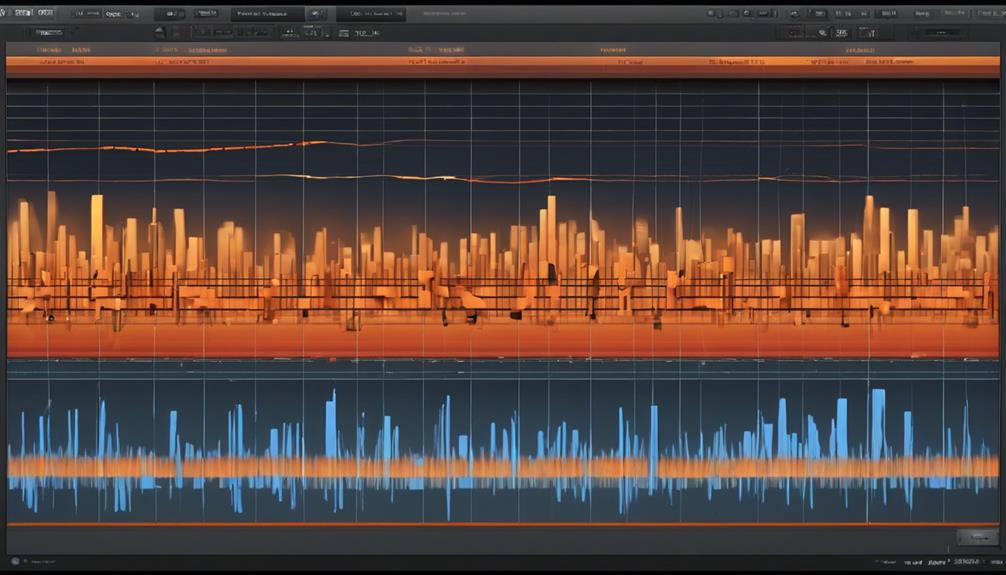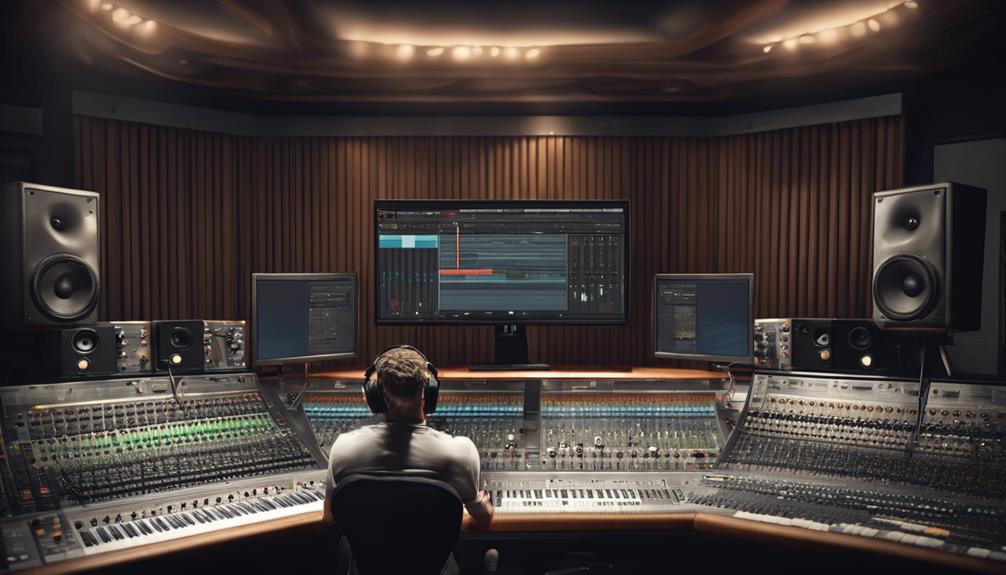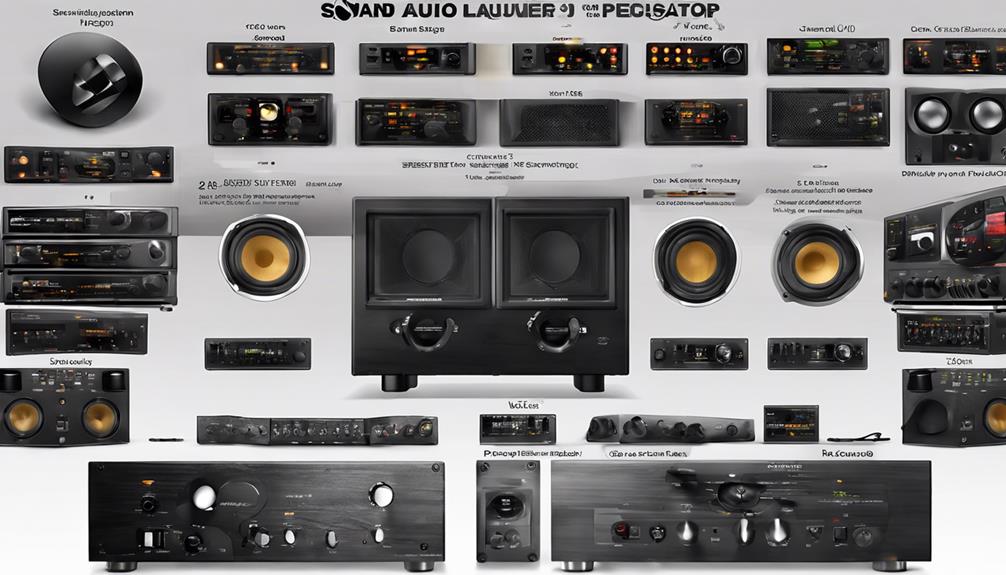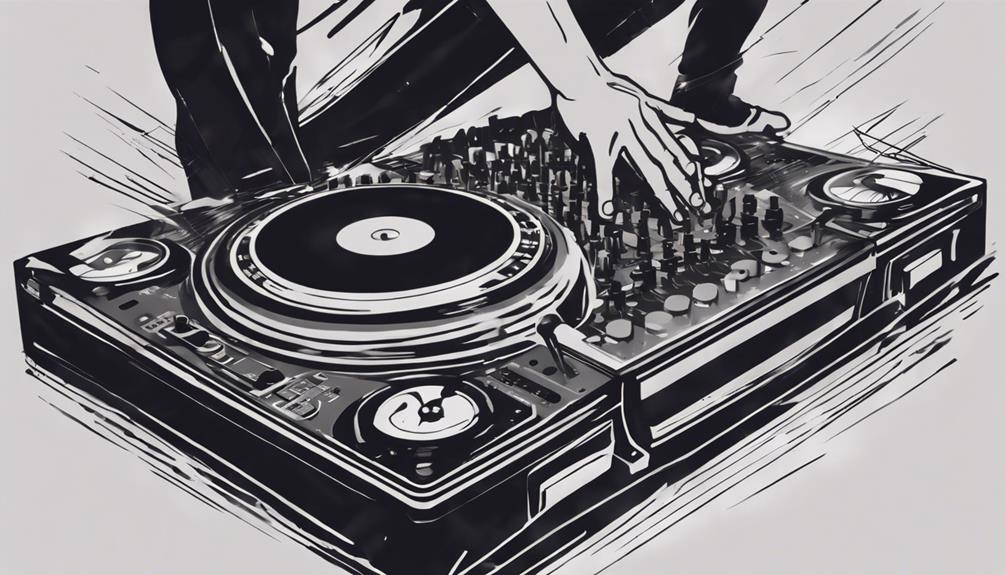When creating song mashups in 10 steps, start by choosing tracks that are in the same key and tempo. Blend songs that are in the same genre and style to create a seamless mix. Ensure that the beats match up perfectly and utilize beat matching tools for smooth transitions. Begin with a basic mix, adjust the levels, and experiment with different connections. Add effects like reverb to give your mix a professional touch. Test your mix on different sound systems and ask for feedback to make improvements. Focus on the small details, such as matching keys and perfecting connections. Let your creativity shine by combining vocals and instruments in unique ways. Each step will help you improve your mixing skills and create polished, innovative mashups.
Key Takeaways
- Select compatible songs in key, tempo, and genre.
- Align beats and tempo for seamless transitions.
- Create a rough mix to blend tracks cohesively.
- Add effects and transitions for a unique touch.
- Adjust sound levels for a polished sound.
Selecting Compatible Songs
When crafting a successful mashup, our initial step involves carefully selecting songs that harmonize in key and tempo for a seamless blend. Matching or compatible keys are vital to guarantee that the shift between tracks is smooth and pleasing to the ear. By considering the tempo and rhythm of the songs, we can create a cohesive fusion that captivates our audience and keeps them engaged throughout the mashup experience.
It is essential to choose songs that complement each other not only harmonically and rhythmically but also in genre, style, and overall feel. This compatibility enhances the unity of the mashup and contributes to a more enjoyable listening experience for our audience. Additionally, mixing popular and recognizable tracks can add an element of familiarity that resonates with listeners and makes the mashup more appealing.
Selecting compatible songs and understanding how they work together is the foundation of creating a successful mashup that flows seamlessly from one track to the next. By curating a thoughtful selection of songs, we can elevate our mashup to new heights of creativity and innovation.
Aligning Beats and Tempo

Properly aligning beats and tempo is fundamental in ensuring a seamless shift between songs in a mashup. When mixing music to make mashups, matching beats and tempo is like weaving a tapestry of sound where each thread complements the other.
Utilize the beat matching tools in your digital audio workstation to synchronize each beat precisely. Adjusting the tempo of tracks is key to aligning them for a smooth and continuous flow in your mashup creation.
This beat alignment not only maintains the energy and rhythm throughout the mix but also elevates the overall listening experience. Consistent tempo matching is the secret ingredient that enhances the fusion of different tracks into a harmonious blend.
Creating a Rough Mix

In crafting a rough mix for a mashup, our focus lies on laying the groundwork for the final seamless amalgamation of tracks. This pivotal stage in music production involves aligning the different songs, adjusting levels, and guaranteeing a coherent blend between them.
By creating a rough mix, we set the stage for the overall structure of the mashup, allowing us to experiment with various song combinations and connections. This phase is essential in the mixing process as it helps us identify any potential issues early on and refine the overall sound of the mashup. It serves as a foundation upon which we can build and perfect a high-quality final product.
Through careful manipulation and adjustment during this stage, we can ensure that the tracks flow seamlessly into each other, setting the stage for the next steps in the music production process.
Adding Effects and Transitions

When creating your mashup, it's essential to improve audio quality by using effects like reverb, delay, and filters. These tools not only aid in forming smooth shifts between songs but also provide a creative edge to your mix.
Trying out reverse effects, stutter effects, and pitch modulation can add a distinct touch to your shifts, making your mashup stand out.
Enhancing Audio Quality
Enhancing the audio quality of a mashup involves adding effects and enhancements to elevate the overall sound experience. By incorporating cool effects like reverb, delay, and filters, you can take your mashup to the next level. These effects can add depth and dimension to the tracks, creating a more immersive listening experience. Additionally, utilizing EQ adjustments and compression can help balance frequencies and control dynamics, ensuring a polished sound. To enhance creativity, consider incorporating unique effects such as stutter edits or pitch manipulation for a fresh and innovative touch. Here is a table showcasing some popular effects and enhancements used in the Art of Mixing:
| Effects | Enhancements |
|---|---|
| Reverb | EQ adjustments |
| Delay | Compression |
| Filters | Stutter edits |
| Pitch manipulation | Creative impacts |
Seamless Transitions Between Songs
With a seamless blend of effects and connections, we can elevate the fluidity and cohesion between songs in a mashup. By using tools like reverb, delay, and filters, we can create smooth shifts that keep the energy flowing.
Experimenting with crossfading, echo, and phasing effects adds depth and continuity to your shifts, making mashups more engaging. Incorporating risers, sweeps, and drops builds anticipation and excitement as you move between tracks.
Utilize beat slicing and stutter effects for dynamic shifts that keep listeners hooked. Layering vocals or instrumentals from one song over another's ending helps seamlessly blend different tracks. These techniques are key to making mashups with smooth shifts that captivate your audience.
Creative Use of Effects
We can enhance mashup creations by skillfully incorporating various effects to add depth and character to the sound. Adding effects such as reverb, delay, and filters can greatly elevate the mix of a song, creating a more dynamic and engaging listening experience.
These effects not only enhance individual audio files but also play an essential role in seamlessly shifting between different song segments. Shift effects like risers, sweeps, and impacts can help blend tracks together smoothly, maintaining the flow of the mashup.
Adjusting Sound Levels

Balancing sound levels in a mashup mix is essential for creating a seamless and harmonious blend of different tracks. When working with new songs, adjusting sound levels becomes important to make sure that each element shines through while maintaining a cohesive sound.
Using audio editing software allows us to fine-tune the volume of vocals, instruments, and effects in the mashup. It's important to pay attention to the dynamics of each track to avoid clipping or distortion when adjusting sound levels. Experimenting with different volume settings is key to achieving a professional and polished sound in your mashup.
Mastering the Final Mix

To achieve a professional and polished final mix of your mashup, utilize audio editing software to fine-tune connections and segments.
The next step is to adjust volume levels, apply equalization, and add effects to enhance the overall sound quality. Make sure to eliminate any unwanted background noise or distortions for a clean and professional final mix.
Review the entire mashup for consistency and make necessary edits or refinements before finalizing the mix. This process guarantees that your mashup is cohesive and well-balanced, offering a high-quality listening experience.
Once you're satisfied with the mix, create a high-quality audio file to share on platforms or with friends for maximum impact. By paying attention to these details and refining your mashup through careful editing, you can elevate your creation to a professional standard that showcases your skills and creativity.
Testing on Different Sound Systems

Testing mashups on various sound systems is essential for guaranteeing consistent quality across different listening environments. By conducting tests on professional studio monitors, headphones, car audio systems, and portable speakers, we can uncover any flaws or inconsistencies in the mix that may necessitate adjustments. It's vital to evaluate how the mashup sounds on both high-end and low-quality sound systems to cater to a wide audience.
Different sound systems offer diverse feedback, helping us optimize the mashup for various listening experiences. Through these tests, we can fine-tune the mix to make sure it sounds great whether played in a high-end studio or on a basic portable speaker. Adjustments made based on testing results can greatly enhance the overall quality and impact of the mashup, making it more enjoyable and engaging for listeners across different sound environments. Testing on a range of systems is a key step in perfecting the art of creating captivating and high-quality song mashups.
Seeking Feedback for Improvement

Seeking feedback from various sources is essential for improving the quality and impact of song mashups. When two songs are put together, testing them at live gigs can provide valuable insights into audience reactions, helping refine the mashups for maximum impact on the dance floor.
It's vital to refine your mashups based on audience feedback as this can elevate the overall experience for listeners and dancers alike. To guarantee a wide selection of tracks for testing and refining mashups, consider downloading necessary songs from extensive DJ pools like ZIPDJs.
Peer feedback is also invaluable; seeking input from fellow DJs, music enthusiasts, or online communities can offer diverse perspectives for enhancing your mashups. Utilizing online platforms to share your creations and gather feedback can lead to valuable insights that may inspire future improvements.
Practicing Attention to Detail

After gathering feedback for improvement, honing attention to detail in mashups involves precise matching of key and tempo, meticulous editing of connections, and careful adjustment of volume levels and equalization.
Matching the key and tempo of songs precisely is fundamental to creating a seamless blend that sounds cohesive and harmonious. By paying close attention to these details, we guarantee that the shifts between different song segments are seamless and fluid, maintaining the flow of the mashup. Additionally, meticulously adjusting volume levels and equalization can greatly enhance the overall sound quality of the final mix, bringing out the best in each song while maintaining a balanced sound throughout.
When we first started experimenting with mashups, we quickly realized the importance of removing any unwanted background noise through careful editing. This contributes to a cleaner and more professional final mix, allowing the main elements of each song to shine through without any distractions. Fine-tuning connections and song segments with precision is essential in creating a captivating and engaging mashup that keeps listeners hooked from start to finish.
Enjoying the Creative Process

Exploring the limitless domain of imagination while crafting mesmerizing mashups is an exhilarating journey filled with infinite possibilities. When it comes to enjoying the creative process of blending songs, there are key aspects to keep in mind:
- Embrace Creative Freedom: Allow yourself to break free from conventional boundaries and let your imagination run wild. Experiment with different genres and styles to uncover unique musical combinations that resonate with your vision.
- Find Joy in the Blend: Revel in the process of merging vocals and instrumentals to construct enchanting mashups. Let the harmony between different songs inspire you and fuel your creativity.
- Stay Open to Surprises: Embrace the unexpected outcomes and creative surprises that arise along the way. Sometimes the best mashups come from moments of spontaneity and experimentation. Enjoy the journey of discovery as you master the art of crafting innovative song mashups.
Frequently Asked Questions
How Do You Make a Good Mashup of Songs?
Making a good mashup of songs involves selecting tunes that match in key and tempo, blending vocal and instrumental tracks creatively, and refining connections with audio editing tools. Paying close attention to segment arrangements and flow is essential for a seamless mix.
Once you've perfected your mashup, share it on platforms like SoundCloud and YouTube to gain exposure and gather feedback. Mastering the art of mashups requires practice and a keen ear for harmonious combinations.
How Many Songs Should Be in a Mashup?
When creating a mashup, the number of songs to include depends on the complexity and vision of the final product. Some mashups might blend two tracks for simplicity, while others may incorporate elements from multiple songs for a more intricate mix.
The decision on how many songs to use is driven by creativity and innovation, from crafting a seamless blend with a few songs to constructing a multi-song masterpiece for a diverse musical experience.
What Are Good Song Mashups?
Good song mashups are blends of different tracks that harmoniously mix key and tempo for smooth shifts. They often use popular songs to appeal to a broad audience.
A well-executed mashup showcases creativity and skill, gaining recognition for its unique sound. By seamlessly merging tracks, good mashups create an innovative listening experience that captivates audiences.
These mixes highlight the artistry of the creator and can lead to increased appreciation for their work.
How Do I Know What Songs to Mashup?
When deciding on songs to mashup, we focus on harmonious keys, tempos, and engaging tracks for the audience. We blend genres and styles creatively for a unique mix.
Cohesiveness is key, ensuring smooth shifts between songs. Themes guide our selections, creating an immersive experience.
The goal is a dynamic playlist that captivates listeners and showcases our artistry.
Conclusion
In mastering the art of song mashups, we blend melodies and rhythms to create something entirely new. Just like mixing colors on a canvas, the possibilities are boundless when it comes to music.
By following these 10 simple steps, we can unleash our creativity and craft unique soundscapes that resonate with others. So let's embrace the magic of music, experiment fearlessly, and let our imaginations soar through the power of song mashups.










